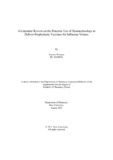A literature review on the potential use of nanotechnology to deliver prophylactic vaccines for influenza viruses

View/
Date
2021-08Publisher
Brac UniversityAuthor
Bhuiyan, SayemaMetadata
Show full item recordAbstract
The influenza virus is the cause of the life-threatening influenza disease, which kills thousands of people each year. Vaccination is the most effective approach to avoid it. To prevent the influenza virus, many types of conventional vaccines have been employed, each of which is designed for a specific strain. However, there is still a risk of an influenza outbreak due to antigenic drift and shift. Nanotechnology platform is used in vaccine development to overcome the drawbacks of conventional vaccinations, which employ nanoparticles with a size less than 100nm. Moreover, targeted delivery, long-term release and therefore long-lasting effectiveness, and single-dose vaccination are all advantages of nanoparticle vaccines over conventional vaccines. Some influenza nanovaccine that have been on the market for a few years and are effective against some strains of the influenza virus. Researchers have been working to develop a universal influenza nanovaccine that would give protection against all influenza virus strains. This review aims to look at how nanotechnology could be used to develop and manufacture prophylactic influenza vaccines, as well as several prophylactic nanovaccine trials that have been successful and are currently in various phases of clinical stages. Furthermore, this review will concentrate on all of the possibilities that future researchers would have with various forms of nanocarriers in the combat against influenza virus.
